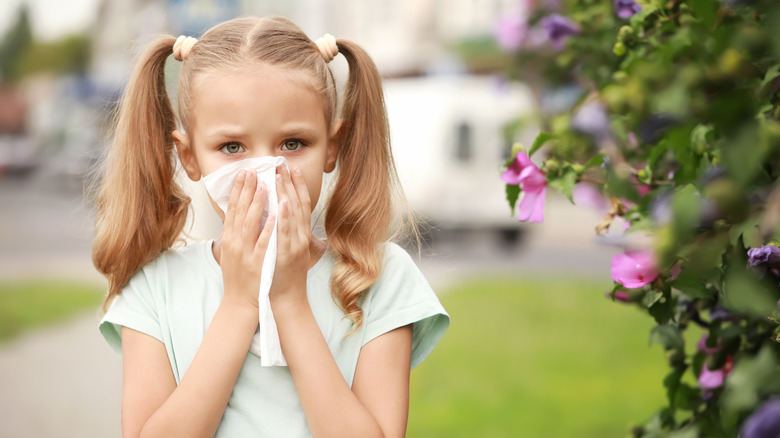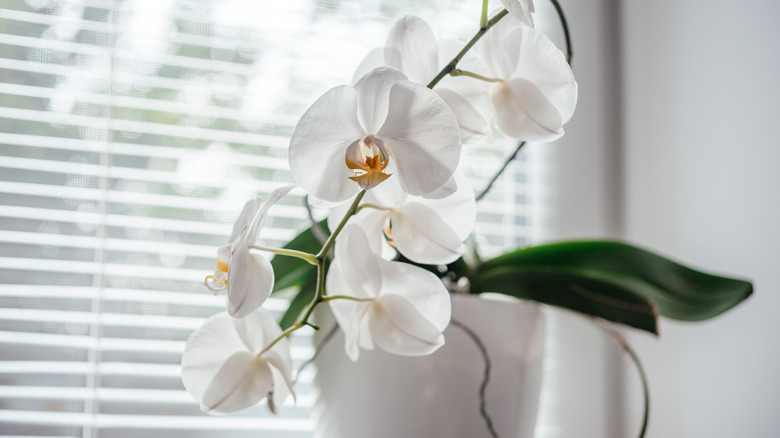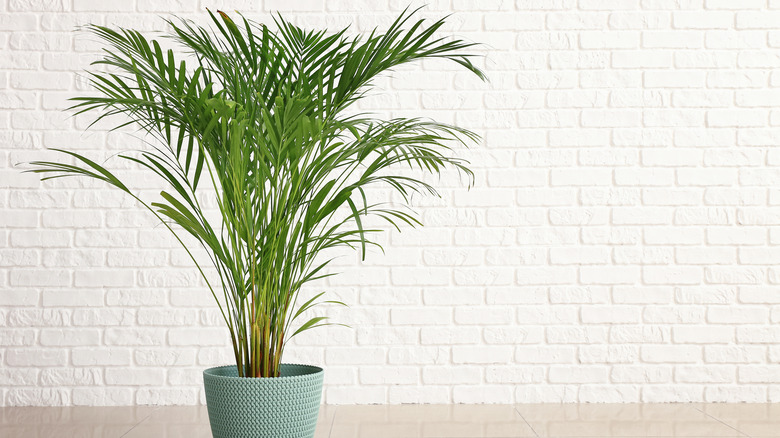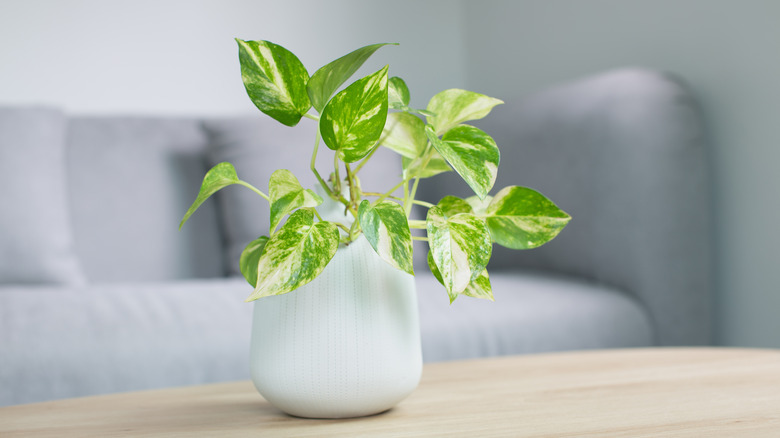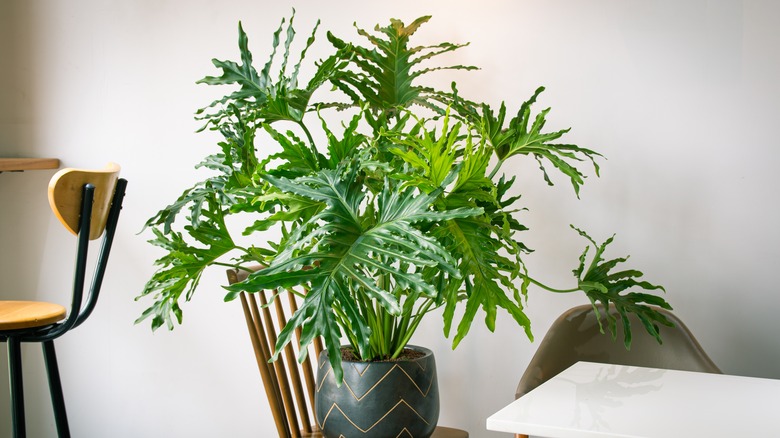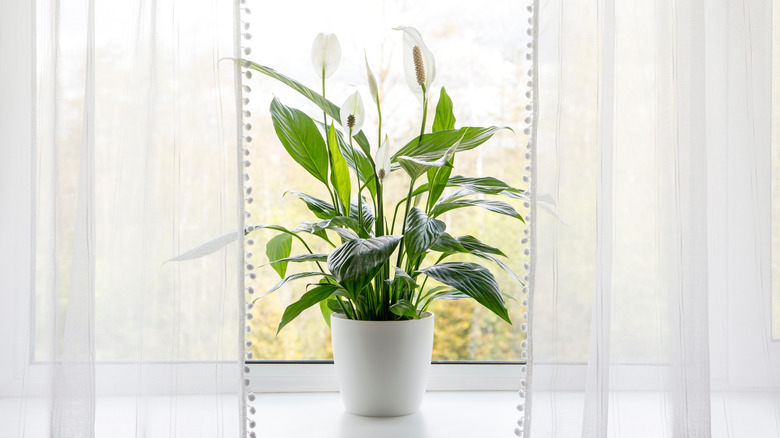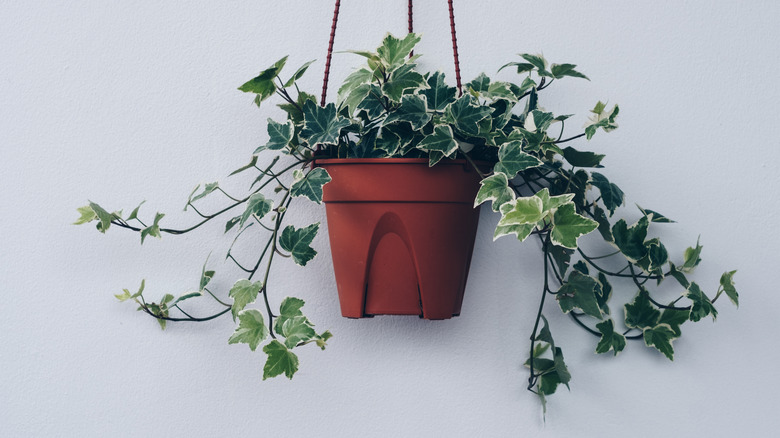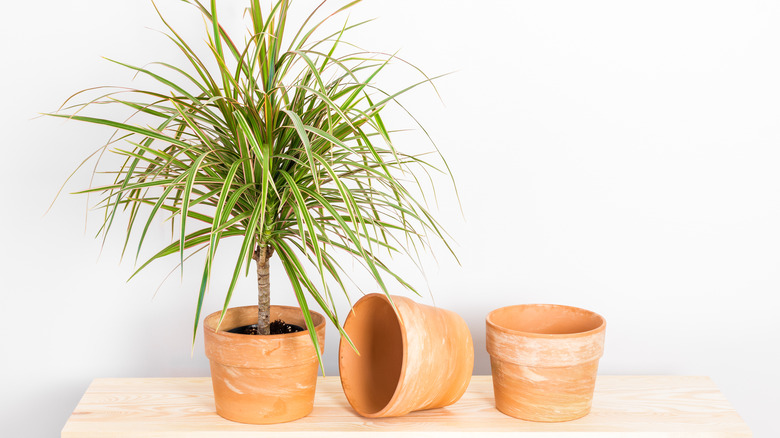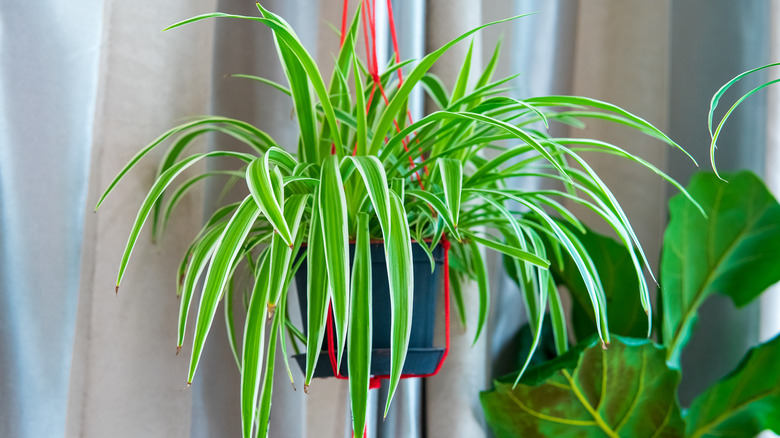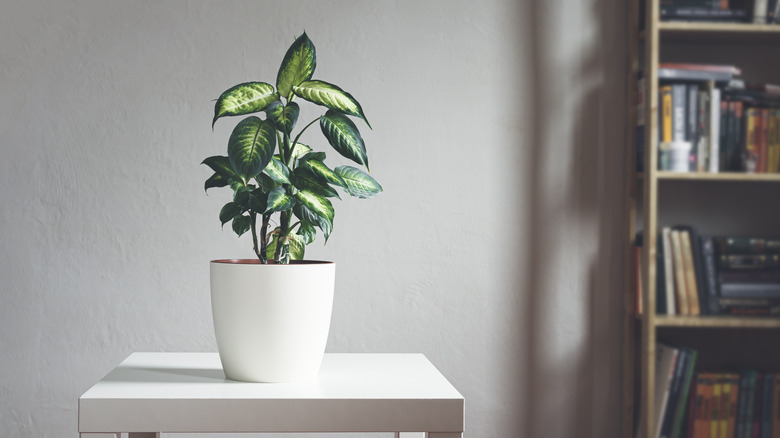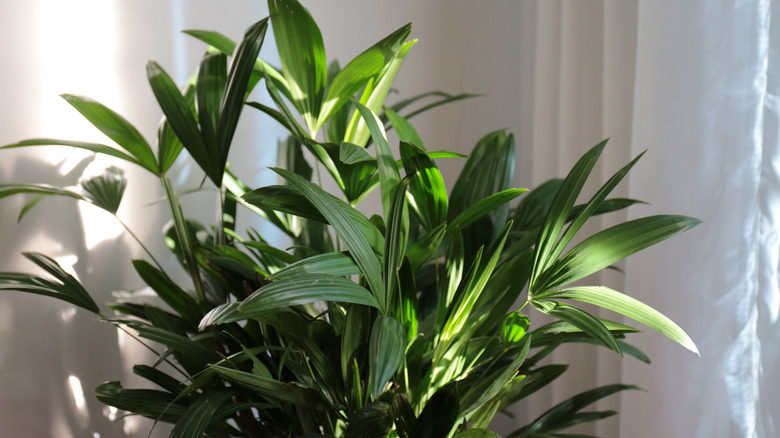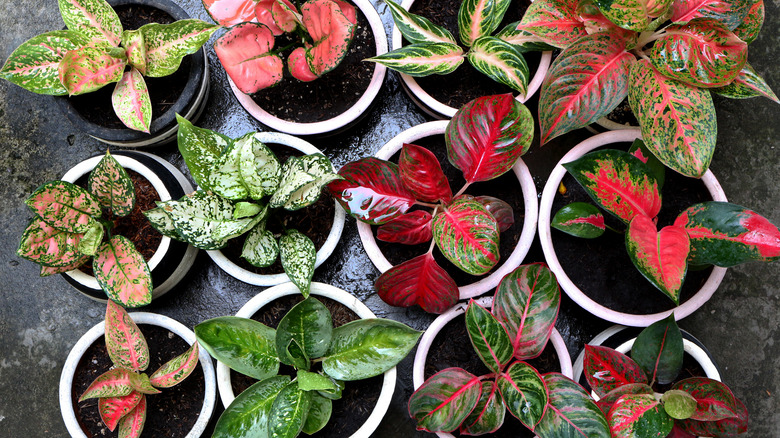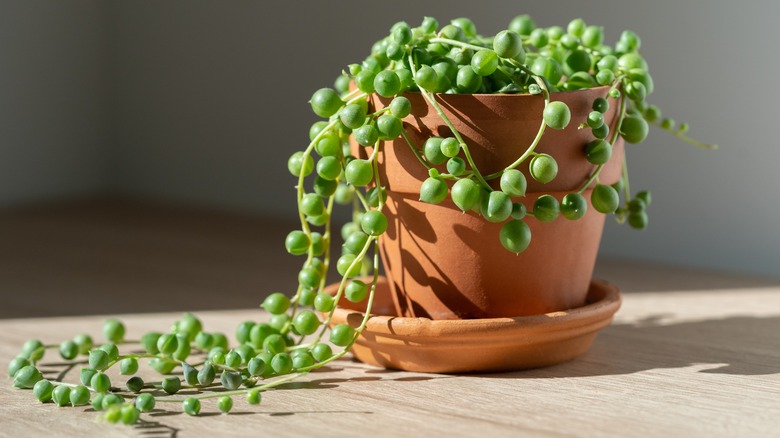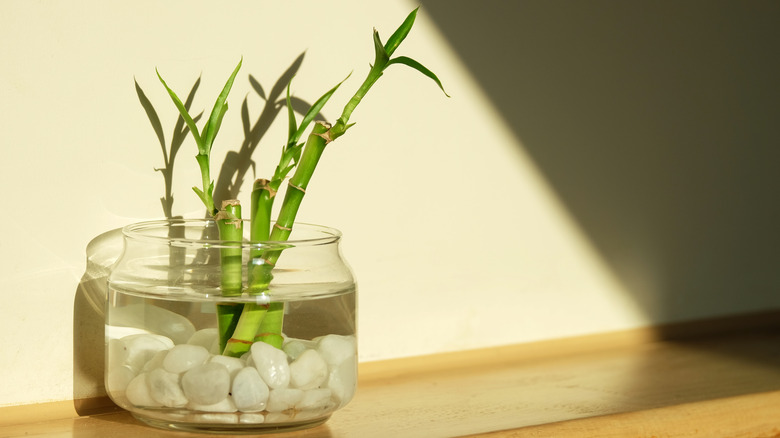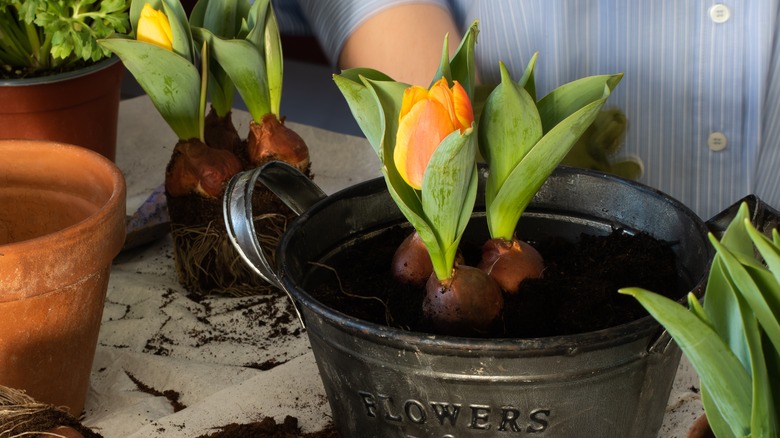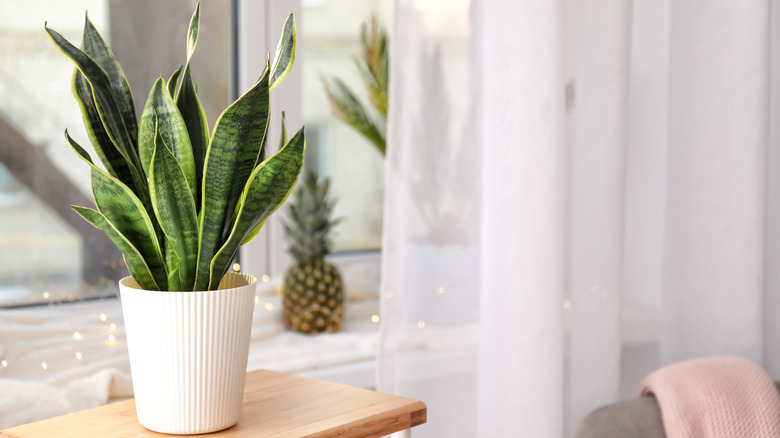15 Best Houseplants For People With Allergies
When you suffer from seasonal allergies, it's natural to avoid plants at all costs, especially those with flowers filled with irritating pollen. Likely, you've been taking all the steps to avoid allergy attacks by using pricey air purifiers, diligently cleaning air filters, and frequently taking allergy medication. More than 50 million Americans experience allergies and acute allergic reactions every year, and they remain among the most common health issues affecting children here in the United States, according to the Asthma and Allergy Foundation of America.
Though there is no cure for allergies, the possibility of experiencing them shouldn't keep you from owning houseplants, which have been shown to improve your sense of well-being, reduce stress, and support cognitive health, as reported by Piedmont. Many types of houseplants are hypoallergenic and some may improve the air quality inside your home. There are even flowering plants like tulips and orchids that contain very low levels of pollen. Here, we've created a list of flowering and nonflowering plants that will not worsen your allergies when kept and grown in the home.
1. Moth orchid
Moth orchids (Phalaenopsis spp.) are known as one of the most hypoallergenic flowers you can grow at home. Their low pollen count allows you to enjoy caring for a beautiful indoor plant without suffering a runny nose and itchy eyes. As noted by the University of Maryland Extension, moth orchids are quite easy to grow, but you'll need to make sure to water yours sufficiently.
Bloom Season: Winter to spring
USDA Growing Zone: 11 to 12
Growing Conditions: Bright, medium, or low indirect light
Soil Type: Loose potting medium
Size: 3 ft tall
2. Areca palm
The areca palm (Dypsis lutescens) is a tall-growing houseplant that may act as a natural humidifier. According to North Carolina State Extension, it has been proven that these palms improve indoor air quality, making them highly sought-after houseplants. They grow well in containers, however, you should be warned that they can be somewhat high maintenance.
Bloom Season: Summer
USDA Growing Zone: 10 to 11
Growing Conditions: Full sun to partial shade
Soil Type: Well-draining
Size: Up to 10 feet tall
3. Golden pothos
Golden pothos plants (Epipremnum aureum) are among the best air-purifying plants on the market. They are known to remove toxins such as formaldehyde from the air, so you can breathe easier all year round. The Sill explains that this climber with an aerial root system is easy to grow, but you should make sure to provide it with a drink on a regular basis.
Bloom Season: Does not flower
USDA Growing Zone: 10 to 12
Growing Conditions: Bright, medium, or low indirect light
Soil Type: Well-draining potting mix
Size: 6 to 10 feet long when grown indoors
4. Horsehead philodendron
Horsehead philodendron (Philodendron bipinnatifidum) is a common houseplant, per Missouri Botanical Garden, but did you know that it does more than simply liven up your living space? Philodendron plants such as this one also clear the air in your home of formaldehyde, which is linked to irritation of the eyes, nose, and throat.
Bloom Season: Seasonal bloomer, rarely blooms indoors
USDA Growing Zone: 9 to 11
Growing Conditions: Low to medium light
Soil Type: Moist, rich
Size: 10 to 15 feet tall, much smaller when grown indoors
5. Peace lily
The peace lily plant (Spathiphyllum spp.) is a shockingly low-maintenance flower given how intricate and gorgeous it is. It shows off attractive foliage and blossoms while also purifying the air in your home. Still, the plant does contain toxic properties that can be dangerous if swallowed, explains Clemson Cooperative Extension. Because they are actually toxic to dogs and may harm children, keep yours high on a shelf.
Bloom Season: Spring
USDA Growing Zone: 10 to 11
Growing Conditions: Bright indirect light
Soil Type: Well-drained potting mix
Size: 1 to 6 feet tall
6. English ivy
English ivy (Hedera helix) is most commonly seen growing in sloping yards and on top of fences and rock walls. However, it's also a popular indoor plant where it will be happy in hanging baskets or containers. This trailing plant can be a pest when grown outdoors as it becomes weedy, mentions North Carolina State Extension. Indoors, though, it is ornamental and clears the room of airborne irritants.
Bloom Season: Fall and summer
USDA Growing Zone: 4 to 13
Growing Conditions: Low to bright indirect light
Soil Type: Well-draining
Size: 20 to 80 feet long
7. Dragon tree
Dragon trees (Dracaena marginata), which are related to other popular Dracaena species such as lucky bamboo, corn plants, and snake plants, are relatively tall growing houseplants known for their spiky foliage, as explained by The Sill. This foliage is typically green, however, there are variegated varieties of the plant that show yellow, pink, white, or orange coloring.
Bloom Season: Spring
USDA Growing Zone: 10 to 12
Growing Conditions: Medium to bright light
Soil Type: General-purpose potting soil
Size: 16 to 40 inches tall
8. Spider plant
The spider plant (Chlorophytum comosum) is among the top recommended houseplants for people with pets, children, busy schedules, and allergies. This specimen, filled with thin spikes of arching foliage, is air-purifying, non-toxic, and neglect-tolerant. With a spider plant you can brighten up a space while making sure your home stays allergy-friendly. Keep it near a bright window for the best growth, recommends the University of Wisconsin-Madison.
Bloom Season: Spring
USDA Growing Zone: 9 to 11
Growing Conditions: Medium to bright light
Soil Type: General-purpose potting soil
Size: 12 to 15 inches tall
9. Dumb cane
The dumb cane plant (Dieffenbachia spp.) can be a wonderful addition to a living room, bedroom, or office provided you can give it enough indirect sunlight. This tropical-looking plant is available in a wide range of cultivars that feature unique variegations and lily-like flowers, explains Miracle-Gro. Be warned, this is another plant that shouldn't be grown around kids. It gets its nickname for making people become mute when they consume its toxic sap.
Bloom Season: Rarely flowers
USDA Growing Zone: 11 to 12
Growing Conditions: Bright indirect light
Soil Type: Lightweight potting mix
Size: 6 feet tall
10. Lady palm
Lady palms (Rhapis excelsa) are lowlight-loving plants that do very well in containers indoors. They easily brighten up interior rooms that don't receive much natural light. Like other palm houseplants, this one can live for many years and needs little attention along the way, says the University of Florida. Check out the lady palm's many varieties which show off different leaf styles before you choose one to bring home.
Bloom Season: Spring
USDA Growing Zone: 9 to 11
Growing Conditions: Medium to low light
Soil Type: Well-draining
Size: 6 to 15 feet tall and wide
11. Chinese evergreen
The Chinese evergreen (Aglaonema spp.) is a type of tropical plant that is very easy to grow at home. It features large leaves which may be variegated or colored depending on the cultivar, explains Costa Farms. Considered tolerant of low light conditions, the Aglaonema species is also a slow-growing plant that will fit nicely on a desk in your office for years to come.
Bloom Season: Spring and summer
USDA Growing Zone: 10 to 12
Growing Conditions: Low or medium light
Soil Type: Humus-rich and well-draining
Size: 1 to 3 feet tall
12. String of pearls
The string of pearls plant (Senecio rowleyanus) is known for its interesting leaves shaped like small green pearls and strung together, hence the common name. The University of Wisconsin-Madison describes this plant as an unusual succulent that is relatively low-maintenance. For the best look, you should grow your string of pearls plant in a hanging basket or draped over another container.
Bloom Season: Summer
USDA Growing Zone: 9 to 11
Growing Conditions: Bright indirect light
Soil Type: Well-draining
Size: 1 to 3 feet long
13. Lucky bamboo
Lucky bamboo (Dracaena sanderiana), a member of the asparagus family, is not actually a species of true bamboo. Instead, it is named after the resemblance of its stems to bamboo with their upright growth habit, according to Missouri Botanical Garden. The stems of this plant are commonly trained into shapes that wave or form hearts and loops. Interestingly, dracaena comes from the Greek word for female dragon.
Bloom Season: Rarely flowers indoors
USDA Growing Zone: 9 to 12
Growing Conditions: Medium to low indirect light
Soil Type: Evenly moist substrate
Size: 3 to 5 feet tall and wide
14. Tulip
Tulips (Tulipa spp.) are not just outdoor garden flowers; they can easily be grown indoors with the right kind of care. For people with allergies, tulips are a great option for something colorful due to their low pollen count. However, as explained by North Carolina State Extension, tulip flowers do contain toxic glycosides, so be careful growing them indoors around pets and small children.
Bloom Season: Spring
USDA Growing Zone: 3 to 8
Growing Conditions: Bright indirect light
Soil Type: Well-draining potting mix
Size: 4 to 28 inches tall and 6 to 9 inches wide
15. Snake plant
The snake plant (Dracaena trifasciata) has been reclassified from its original Sansevieria genus to the Dracaena genus. It's well-known as an air-purifying plant needing little water or attention. It will grow in almost any area in your home as long as it isn't exposed to harsh direct sunlight, states Penn State Extension. There are many different cultivars to choose from, including variegated and thin-stemmed varieties.
Bloom Season: Spring
USDA Growing Zone: 9 to 11
Growing Conditions: Medium to low indirect light
Soil Type: Well-drained potting mix
Size: 6 inches to 3 feet tall depending on the variety
